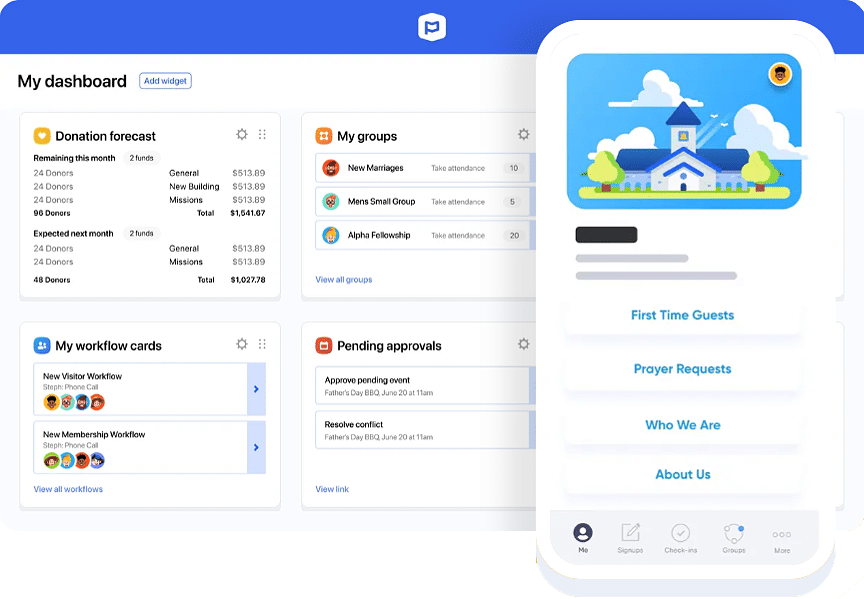Imagine a growing church alive with energy—a packed worship space filled with engaged attendees, children who look forward to church, and welcoming faces at the door.
While growth can be exciting, it won’t come without some growing pains.
Don’t worry, though. Others have gone before you and learned a few lessons the hard way. You can benefit from their experience and maximize the opportunities before you!
Church growth is a gift but also an opportunity to adapt, prepare, and kindle our leadership development. The size of your church affects more than attendance; it influences decision-making, relationships, and leadership roles.
So, how can you possibly prepare for the challenges of church growth and maintain the unity of your community?
Whether you’re just beginning or managing a growing ministry, there are ways to navigate each step along the way.
Navigating the Key Challenges of Church Growth at Every Stage
The late Dr. Timothy Keller (co-founder of Redeemer City to City) once wrote, “A church’s functional style, its strengths and weaknesses, and the roles of its lay and staff leaders will change dramatically as its size changes.”
Leadership plays a role in navigating church growth and using the resources available. There will be barriers, but being proactive allows leaders to address obstacles before they snowball into problems.
The Early Growth Stage: Laying a Strong Foundation
Smaller churches often face resource limitations, a small leadership team, and reliance on volunteers. Members typically have direct access to the pastor, but as the church grows, this becomes less feasible, impacting the personal connection within the church community.
Additionally, leaders are likely juggling multiple roles—pastor, administrator, and community leader—which could lead to burnout or missed growth opportunities.
In the early growth stages, you want to continue volunteer involvement and provide training to help create an engaged and dedicated team. Volunteers can take ownership of initiatives, lightening the leadership load while building the base for ministries that can expand and scale.
People want to be involved in something that matters. God has given each person skills and gifts that they can use to build up the church in every way. Small churches are uniquely positioned to build up the church by equipping and empowering people to serve.
Overall, focus on building a welcoming environment that invites community participation. Core ministries, like children’s programs or prayer groups, can also help form the foundation of a strong and lasting church.
The Expansion Stage: Scaling Ministries and Building Structure
Maintaining a smaller church’s warm, community-focused atmosphere as the church grows numerically can be challenging. Many people fear losing this sense of connection as they expand. That means that leadership teams must now oversee organized ministries and possibly hire more staff to meet increasing demands.Recruiting ministry leaders can relieve overstretched pastors and help manage new programs. Leaders should focus on role assignments, which help with strategic delegation across growing responsibilities – without forfeiting caring for people’s hearts.
To preserve community bonds, create small groups or fellowship opportunities. These give members a way to stay connected, fostering relationships that mimic the closeness of smaller congregations while providing spiritual accountability within a larger structure.
The Organizational Stage: 3 Ways to Manage Complexity and Growth Barriers
Decisions made during the organizational phase will impact your church’s health. Without solid systems, leaders can become overwhelmed, which trickles down to the staff and community.
1. Strategic Communication
With more people involved, signals can often get mixed, whether in meetings, emails, or bulletins. Members can also easily feel left out or disconnected due to a lack of updates or disorganized staff.
2. Effective Tools
Misunderstandings or gaps in member engagement happen as churches grow, so digital software can be valuable to your management style. Invest in administrative systems like church management software, like Planning Center or Pushpay, to streamline operations like event planning, volunteer scheduling, and general communication.
3. Delegation
Assigning trusted members to different tasks can make church management easier and more organized as your community gets larger in size. Build a leadership team dedicated to specific areas of church operations—such as hospitality or outreach—to manage responsibilities better and ensure no leader is stretched too thin.
The Established Growth Stage: Sustaining Momentum and Preventing Stagnation
After a church experiences a growth spurt and people settle into a “new normal,” it’s common for the excitement to fade from leaders, staff, and the community. Keep the joy alive! You can do this by offering new programs and identifying fresh perspectives to engage the community.
Begin by assessing both the community’s needs and your church’s programming. Ask yourself:
- Are there ministries needing improvement?
- Is there an opportunity to launch a new outreach effort?
- Who can help with brainstorming new initiatives?
One effective approach is to create a culture of continuous learning. Offering educational opportunities that align with your church’s God-given vision inspires people and strategically supports ongoing growth.
For example, you could organize workshops on leadership, lessons on financial management, or strategically create space in your church building to meet the needs of your community.
The Community Impact Stage: Expanding Influence and Reinforcing Mission
Looking to make a broader impact outside of your growing church? Consider community-centric outreach programs and engagement opportunities in your hometown.
Focus your outreach on areas that match your church’s mission and values. Whether hosting food drives for the underserved or creating mentoring programs for neighborhood youth, these initiatives should be meaningful and manageable for your team.
Partnerships with other organizations are another way to expand your reach without stretching your resources. Many businesses around your town may have shared goals, which can go a long way toward building large-scale initiatives that feel authentic to your community.
Preparing for Growth with Catalyst Construction
From laying a strong foundation to making a meaningful community impact, each phase of church growth comes with challenges, requiring leaders to remain flexible and open to available resources and help from others.
Don’t wait for growth hurdles to appear—take proactive steps in guiding your church toward a Godly future.
Contact the experts at Catalyst Construction today to explore how we can help you build a strong foundation for sustainable church growth.







